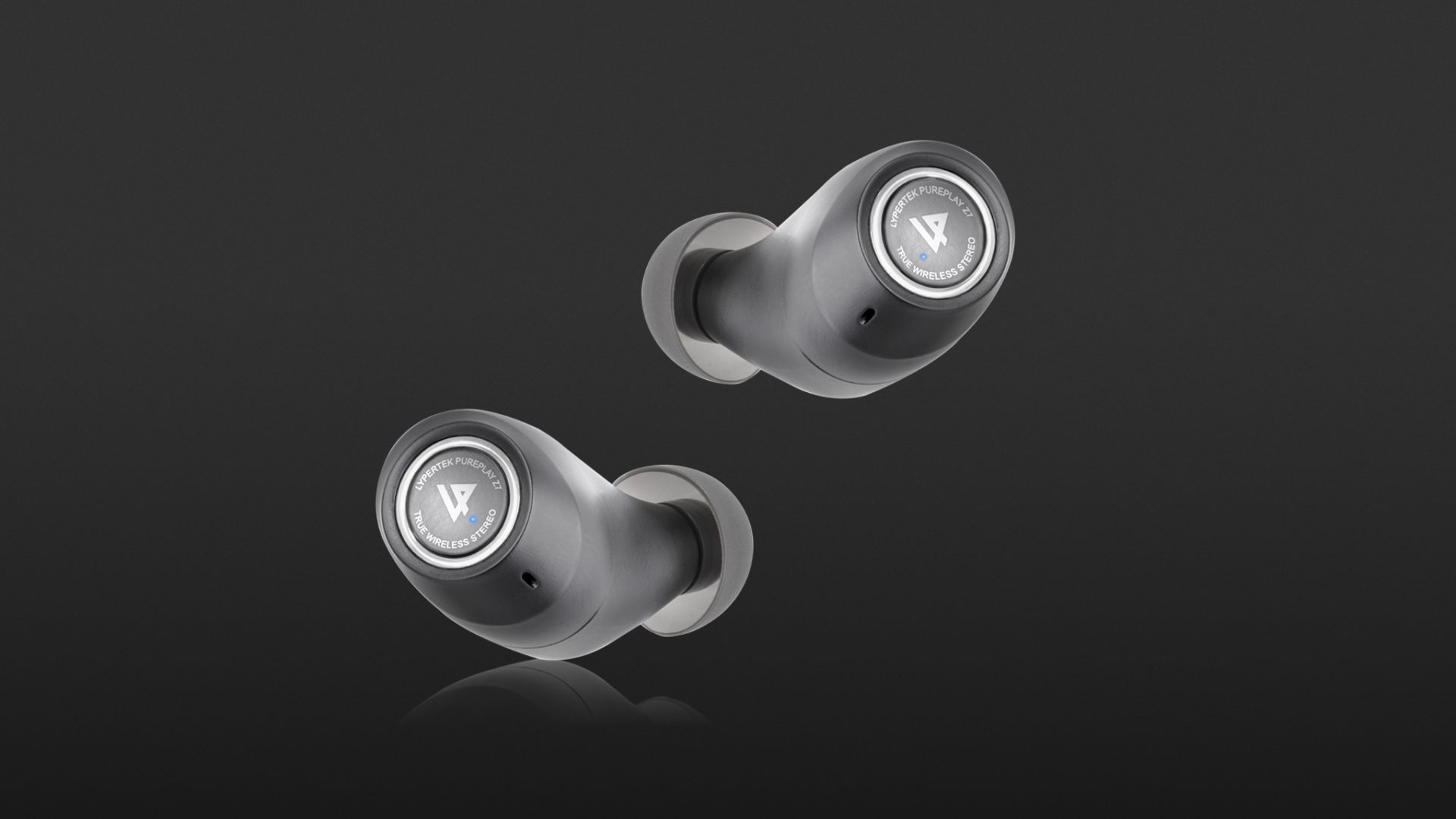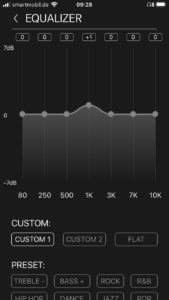Lypertek’s PurePlay Z7 positions itself as a True Wireless system for those with higher sound demands. Compared to their PurePlay Z3, these headphones are a step up, which without a doubt justifies the price being doubled. At a price of 199 Euros, these headphones, which also impressed me with their effective operation and exceptionally good battery life, can comfortably hold their own against industry giants Apple and Sony on sound quality alone. In short: a genuine recommendation.
The new premium model among the True Wireless headphones from Lypertek is an upgraded version of the model formerly called TEVI (now – PurePlay Z3, here’s the previous review). The Chinese manufacturer has set higher standards for sound quality. The PurePlay Z7 uses a hybrid driver configuration. For the first time, Lypertek is using one titanium-coated dynamic driver and two balance-armature drivers on each side; these work together in tuned frequency ranges in a correspondingly tuned housing and are thus supposed to ensure particularly good detail resolution.
The lightweight PurePlay Z7s are not particularly small and protrude from the ear somewhat. However, they fit securely – thanks to the generous selection of silicone and memory foam adaptors. In addition to exceptionally good external insulation, the wearing comfort is also impressive, even during longer listening sessions.
Their black design is rather understated, but the workmanship is robust. These headphones are also protected against moisture and sweat according to IPX5 and are therefore suitable for sports.
As with the smaller models, Lypertek deliberately avoids touch sensors on the outside of the earpieces, as these can often result in mistakes on competitor models. Instead, a smooth-action large button is used on each side. Also, Lypertek products of the current generation can be controlled via a free app, “PureControl”, which promises additional convenience.
In practice
The first noteworthy feature is the battery power. These headphones run for around ten hours and can be extended by a further 70 hours via the charging case (according to the manufacturer’s specification, depending on volume). In this respect, the PurePlay Z7, like its little brother, the PurePlay Z3 2.0, occupy a top position among True Wireless earphones. The disadvantage: These headphones are quite large, and their textile-covered charging case with a multi-coloured status LED is a size larger than usual, but it is still pocket-compatible. The charging case scores points with a fast-charging function (15 minutes charging time for about two hours playing time) and supports inductive charging, for example, via the brand’s optional Super Slim Wireless Charging Pad https://amzn.to/2TEPgwN – *partner link.
Technically, Lypertek relies on Qualcomm’s QC3040 chipset, which offers an energy-efficient Bluetooth 5.2 wireless link as well as support for the audio codecs AAC and aptX. Higher-quality formats, however, are missing from the offering.
The smooth-action buttons can be used to start and pause music playback, accept and end calls. You can jump tracks and adjust the volume with double and triple clicks, and you can even configure the functions of the buttons in the app. In practice, this works reliably once you’ve had a little practice. A longer press of the button calls up a Smartphone voice assistant. If you keep your finger on a button, the Hear-Through function is activated (and announced audibly). This feeds external signals into the headphones for better communication. This function remains active until it is manually switched off. When music playback is switched off, this definitely adds value. If, on the other hand, playback is switched on, it would probably be useful if it lowered the level at the same time.
There are no automatic functions, such as switching off when the headphones are removed from the ears. However, it makes sense to switch off the headphones, which can also be used individually when the charging case is closed. Pairing is quick and confirmed with an announcement after opening the charging case, and this proved stable in practice, even across several rooms.
The free app “PureControl” for iOS and Android offers firmware updates and status information as well as the so-called LDX mode (Lypertek Definition Expander), which is supposed to improve the sound. The differences are rather subtle and, at least to my ears, only noticeable in really quiet environments in the form of a subtly rounder and warmer reproduction. In mobile use, though, I could not reliably determine an improvement in sound. When the LDX function is deactivated, the integrated equaliser, which sounds quite good, can be used with its seven operating frequencies and a range of ±7 dB each. There are a number of pre-sets to choose from and two separate memory locations. For example, you can provide more boost in the bass without annoying side effects or adjust other frequencies to your taste or to compensate for weaknesses in your hearing. Finally, there is a search function for lost earphones. This displays on a map the last time the headphones lost connection to your Smartphone.
Sound
The TEVI had already impressed us with the powerful yet uncluttered sound of its dynamic drivers. The prerequisite, as always, is the right adaptors to make the headphones fit, and in my opinion, these could slide a little more smoothly onto the bracket. The BA drivers of the PurePlay Z7 build on the basic TEVI sound and expand the sound spectrum in a useful way. The foundation is a deep bass reproduction, which should and does reach the upper sound level through extended details and spatial resolution in the mids and highs. In fact, the sound image gains in lightness and frees the 6 mm driver from the burden of the higher frequencies, which actually increases the impression of bass pressure. Nevertheless, or perhaps precisely because of this, the bass is always defined in its contour and tonality. It also reliably reproduces the desired dynamics down to the low bass (Adel Tawil: “Katsching”). The best thing: The bass reproduction does not interfere with the higher frequency ranges. For example, Nick Cave’s voice on “Galleon Ship” has a clear place in the sound image, despite the deep dark growl. This is very successful and can be adjusted as needed via the equaliser in the app. It’s striking that the PurePlay Z7 is capable of powerful levels and yet hardly ever loses precision.
Thanks to the driver separation, I have no complaints in the midrange either: the headphones we tested succeed in bridging the gap between pressure, warmth and presence as well as proximity or size. This applies across genres from electronic pop music (Goldfrapp: “Systemagic”) to wide guitar walls (Slayer: “Repentless”), intimate recordings to a classical symphony orchestra with pronounced dynamics.
The treble range is also pleasantly open and fast. It thus delivers the necessary details, in voices and instruments, in the stereo panorama and room, as well as a pleasant sparkle. True, it doesn’t come close to true audiophile open or electrostatic designs, but you shouldn’t expect that at a price of 199 Euros.
There is no unwanted harshness. In fact, the PurePlay Z7 are a bit too tame for my taste (Britney Spears: “Toxic”).
Finally, the headphones we tested also convinced me with a stable, wide and confidently articulated stereo image. With this attention to detail, for example in St. Vincent’s “Daddy’s Home”, listening pleasure is inevitable. As expected, there are limits to the depth of this in-ear system. However, reverberation chambers are clearly discernable, for example in Holly Cole’s “I Can See Clearly Now”.
The noticeable external insulation, which incidentally also protects the person sitting next to you from annoyance, ensures a really good signal-to-noise ratio. On the other hand, at least for me, there was sometimes a perception of impact sound when I was walking.
You may have noticed: The PurePlay Z7 deliberately does without noise cancelling. Whether you want this function or not is certainly situation-dependent. According to the German distributor, Lypertek rely on high driver quality and good external insulation and thus avoids the possible disadvantages of ANC such as potential background noise and the possibility of restrictions in the frequency response. Conversely, it should be noted: If it is noisier outside, the quiet zone created would definitely outdo the passive noise isolation created by a good noise-cancelling system, which is an advantage when travelling by train and plane. Last but not least, there are deductions in points for speech intelligibility during phone calls, which the person I called criticised as not being clear enough despite noise cancellation.
Technical specifications
- Ear couplingIn-ear
- Typeclosed
- Transducer principledynamic + 2 balanced armature drivers
What's in the box
- Silicone ear tips (3 pairs)
- Memory foam ear tips (3 pairs)
- USB-C charging cable
- Filtermesh
- Charging case
Special features
- BT codecs: SBC, AAC, aptX
- BT version: 5.2
- BT profiles: A2DP, AVRCP, HFP, HSP















































